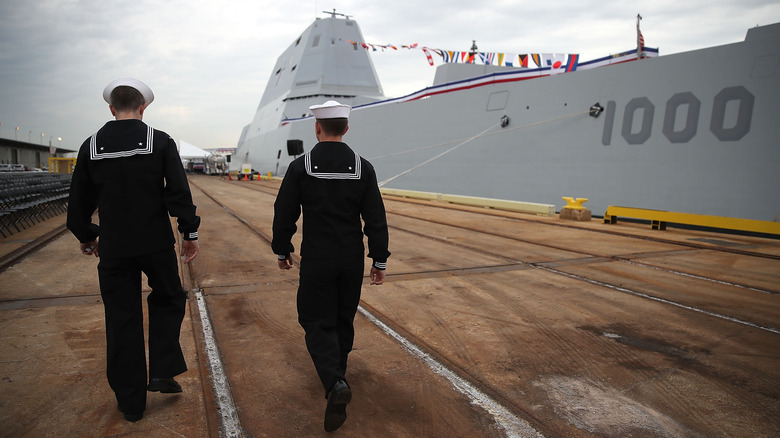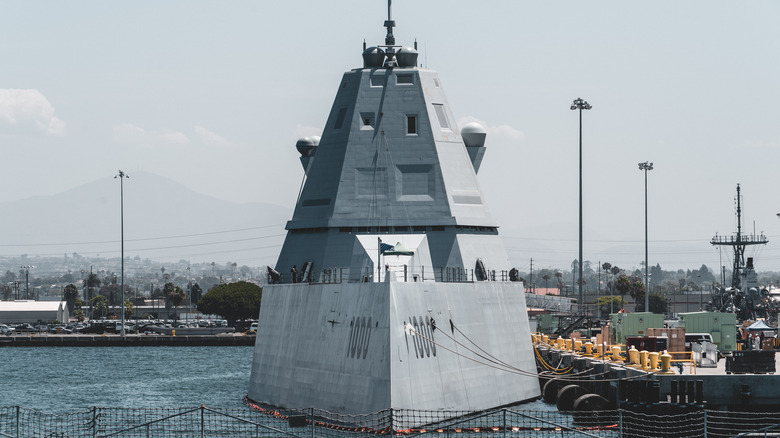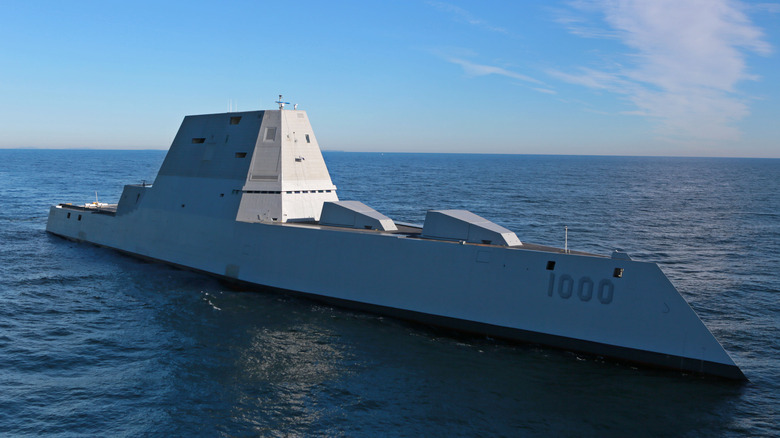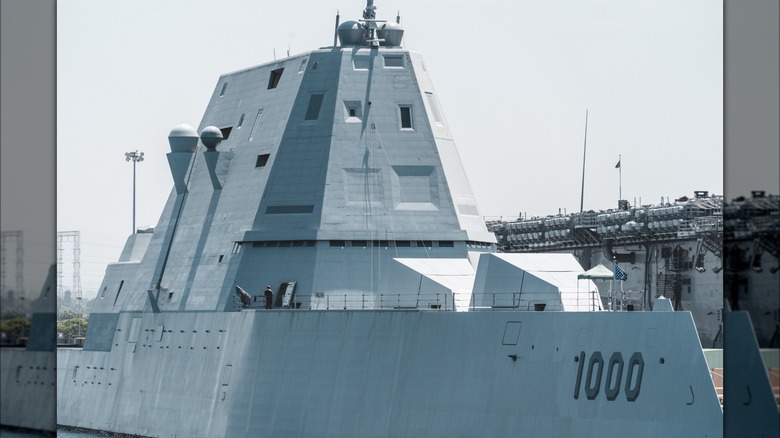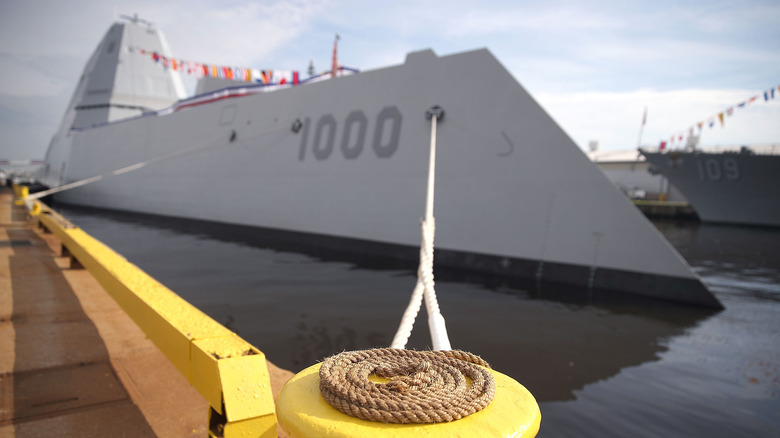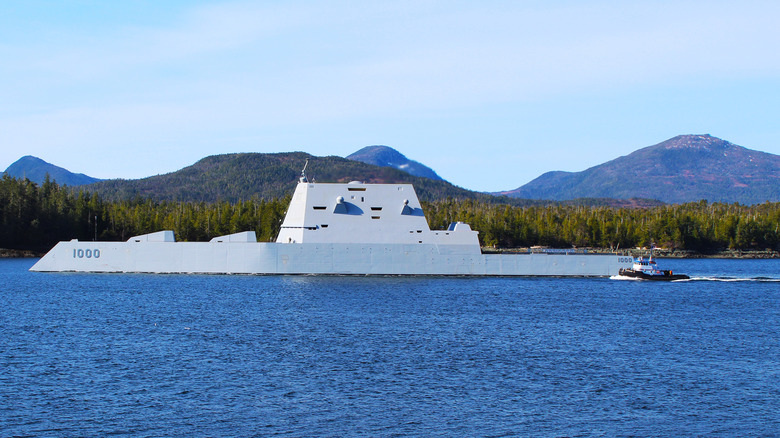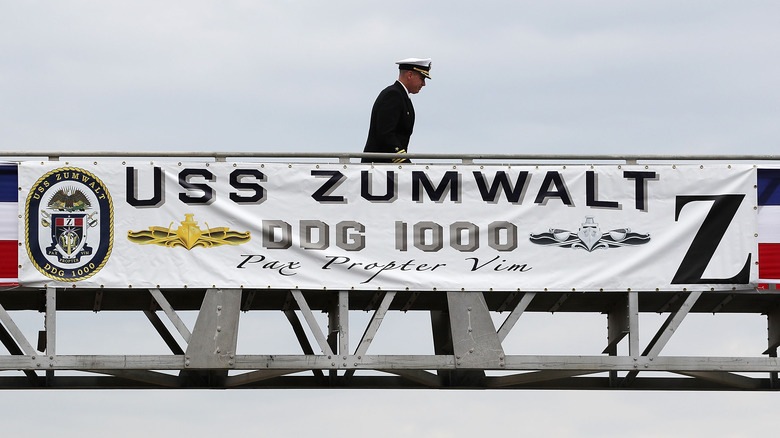Secrets Of The USS Zumwalt: The Largest Destroyer Ever Built
The first ship of any new class is named for both the ship and the its classification. The first Nimitz class carrier was named the USS Nimitz and the first Arleigh Burke-class destroyer was named the USS Arleigh Burke. It's a distinction that will live on in naval history.
The USS Zumwalt belongs to a new line of ships designed for the US Navy, originating from the DD-21 program aimed at developing a 21st-century destroyer. Creating the Zumwalt class ship was a challenging and lengthy process, as it faced budget constraints and nearly got canceled. Originally, the plan was to build 32 of the destroyers, but only three received funding and were constructed.
The maiden launch of the first USS Zumwalt took place a decade ago. Rigorous testing and sea trials have been conducted, making it into one of the most technologically advanced destroyers in existence. The ship boasts cutting-edge weapon systems, automation technology, and a powerful and reliable propulsion system. Over the course of 10 years, it has undergone retrofits and tested the latest military weaponry.
Today, we delve into the secrets of the USS Zumwalt: the largest destroyer ever built, to uncover the impressive capabilities and groundbreaking features of this engineering marvel.
DDG-1000
As the flagship of the cutting-edge Zumwalt class of destroyers, the USS Zumwalt received a new designation, departing from the previous naming system. The preceding class of Destroyers, known as the Arleigh Burke class, concluded with DDG 139. However, the USS Zumwalt represents a significant leap forward in naval capabilities, showcasing an array of advancements in its designation, mission capabilities, and equipment.
The DDG-1000 and other vessels of the Zumwalt class are designed as flexible ships, capable of carrying out a wide variety of missions. In contrast to its predecessor, the Arleigh Burke class, the Zumwalt class boasts a substantially larger size, enhanced armaments, but also came at a much higher cost. This is typical for a new and untested combat ship, as it involves pioneering new components and designs, which can lead to higher expenses initially. However, as shipyards like Bath Iron Works learn and streamline processes, future iterations are typically expected to become more cost-effective.
Originally, the planned commission of Zumwalt class ships was more extensive, but due to budget constraints, only three ships were ordered. The remaining ships were canceled. The USS Zumwalt marks a promising step toward the future of naval warfare, featuring unparalleled capabilities, but its development needs thorough testing and refinement to ensure its operational effectiveness.
Admiral Elmo Russell Bud Zumwalt Jr.
The USS Zumwalt and the Zumwalt class are named after Adm. Elmo Russell Zumwalt Jr. He has the distinction of being the youngest admiral ever promoted in the U.S. Navy at the age of 44 and later became the youngest four-star admiral in naval history.
Throughout his distinguished naval career, Adm. Zumwalt served in various conflicts. During World War II, he was aboard the USS Phelps during the Battle of Leyte Gulf, where he received the Bronze Star in recognition of his valor. Subsequently, he earned his first command, leading the USS Tills, which was later called up during the Korean War. Admiral Zumwalt's exceptional actions with the USS Wisconsin battle group through treacherous waters laden with mines earned him a combat ribbon.
Upon his promotion to admiral, he took command of multiple fleets, ultimately being appointed as Chief of Naval Operations by President Richard Nixon. In this influential role, he introduced numerous innovative programs and changes. He notably initiated 121 directives known as Z-Grams, which aimed to ease racial and sexist tensions within the Navy while ensuring the retention of high-quality sailors.
Zumwalt passed away in 2000. His profound legacy of combat effectiveness, exceptional leadership, and unwavering commitment to equality live on, and these qualities are commemorated through the naming of the Zumwalt class destroyers in his honor. His contributions and values continue to inspire and guide the US Navy to this day.
Little-Known Facts about the USS Zumwalt
The Zumwalt, the latest addition to the Navy's fleet of destroyers, hides a multitude of secrets amid its decks. Unlike ships of similar size, the Zumwalt provides each sailor with more comfortable, private living spaces called berthings. In the past, junior enlisted personnel on destroyers shared approximately six berthings, with 20 to 50 sailors living together. However, the Zumwalt is different. Even though it is larger, it manages manpower more efficiently by offering more private spaces to its sailors. This means better living conditions and morale for the crew.
Instead of having massive berthings, the Zumwalt adopts a different approach. It groups six personnel together, and they share a stateroom with their own attached facilities. This innovative design optimizes space utilization and enhances the living conditions for the crew.
Even before its keel touched the water, the USS Zumwalt captured media attention. The excitement increased with the announcement of its first captain, Adm. James A. Kirk. It is worth noting that this Adm. Kirk is unrelated to the famous James T. Kirk from "Star Trek." While the similarity in names is purely coincidental, it adds a touch of whimsy and proves Oscar Wilde's famous quote that "Life imitates Art far more than Art imitates Life."
Unmatched Size and Power
The USS Zumwalt's sheer magnitude commands awe, boasting an impressive length of 610 feet and a displacement exceeding 15,000 tons. What sets it apart is the innovative Integrated Power System (IPS) that drives this technological marvel. Unlike conventional destroyers relying solely on gas turbines, the Zumwalt's IPS combines advanced electric propulsion with gas turbine engines, delivering unparalleled efficiency and adaptability.
The IPS grants the USS Zumwalt the ability to operate at a variety of speeds using electric power alone, resulting in remarkable energy efficiency during operations and a significant reduction in its environmental impact. This flexible power system is optimized for low-power operations, ensuring heightened efficiency when operating at lower speeds.
The IPS incorporates state-of-the-art Rolls Royce-designed generators, integrated into the system by General Electric. While the exact maximum power output remains undisclosed to the public, it is widely known to far surpass that of the previous Arleigh Burke class destroyers. This design choice was made to future-proof the USS Zumwalt, paving the way for potential testing of advanced energy-based weaponry, such as lasers.
The USS Zumwalt's Integrated Power System is a testament to cutting-edge engineering making it a truly formidable vessel and a harbinger of advanced naval technology.
Revolutionary Design and Stealth Capabilities
The USS Zumwalt's extraordinary appearance immediately catches the eye with its futuristic and sleek design, reminiscent of a science fiction vessel. Notably, the ship's bow forms a razor-sharp edge, setting it apart from traditional destroyers. However, this striking design is not just for aesthetics; it plays a crucial role in the ship's capabilities.
The revolutionary design, including the "tumblehome" hull form, serves multiple purposes. First, it enhances the ship's stability in rough seas, increasing how it handles in challenging conditions. Second, and most importantly, it significantly reduces the ship's radar signature, making it incredibly difficult for enemy detection systems to spot. The seamless hull, with slanted frames and concealed connections, effectively conceals the USS Zumwalt from radar, rendering it virtually invisible to adversaries.
One of the USS Zumwalt's most significant secrets lies in its stealth technology. The vessel is carefully engineered to minimize its radar cross-section, featuring a smooth and angular design, along with advanced radar-absorbing materials. This ingenious approach makes the ship appear much smaller on enemy radar screens, drastically reducing its detectability and tracking capability. Consequently, the USS Zumwalt gains a critical advantage in modern naval warfare, as its reduced visibility enhances its survivability and facilitates successful operations with a strategic edge.
Cutting-Edge Technology and Weaponry
The USS Zumwalt has undergone a substantial investment by the U.S. Navy, amounting to billions of dollars, to develop cutting-edge capabilities. These include powerful generators, surpassing those found on all but the largest naval vessels, advanced automation technology, and state-of-the-art weaponry.
The vessel's all-electric propulsion system brings several advantages, such as heightened efficiency, reduced fuel consumption, and longer-term mission capabilities. Moreover, the advanced communication infrastructure significantly enhances situational awareness and facilitates seamless coordination with other naval assets, optimizing combat effectiveness.
The decision to reduce the crew capacity by half compared to the previous class of destroyers is attributed to the integration of advanced automation systems. Notably, the bridge, which typically requires a crew of about five to 10 sailors on the Arleigh Burke-class, can be effectively managed by a single sailor if necessary on the Zumwalt. Multiple systems are centralized and controlled through panels on the bridge. While more than one person usually operates the bridge, the ship is designed to allow a single sailor to steer and take command in emergencies.
The U.S. Navy has harnessed the vessel's advanced power and automation capabilities to create various cutting-edge weapons systems for the Zumwalt class. Initially, a promising electromagnetic railgun project was in development, alongside advanced radar systems and a vertical launch missile system. However, it is important to note that the railgun project has been recently discontinued in favor of a hypersonic missile project, signifying the Navy's continuous pursuit of the most effective and modern weaponry.
The Future of the USS Zumwalt
As the first of its class, the USS Zumwalt set the standard for all future ships. As of now, there are only three Zumwalt class ships in the U.S. Navy. While no additional ships are currently under construction, the data and experiences gathered from these three ships will determine whether more Zumwalt class destroyers are built or if a new class is designed.
The USS Zumwalt is already utilizing the data from its initial deployment to undergo retrofitting, enhancing its versatility and effectiveness. The cutting-edge main guns are being replaced with a new missile launching system, aligning with the Navy's shift towards guided missile systems since World War II. Defense contractors are working on incorporating oversized hypersonic missiles, which cannot fit in the current Vertical Launch System, further advancing its capabilities.
Due to its remarkable power output, size, and specifications, the Zumwalt class ships serve as ideal testbeds for various new weaponry, including laser, sonic, and undisclosed technologies. Their design with excess requirements allows the Navy to experiment with nearly any new system.
As one of the world's most advanced stealth destroyers on the water, the Zumwalt class ships will continue to be used and updated until the U.S. Navy is satisfied with its operational capabilities. While the possibility of more Zumwalt class ships in the future remains, there are currently no active contracts for their construction.
